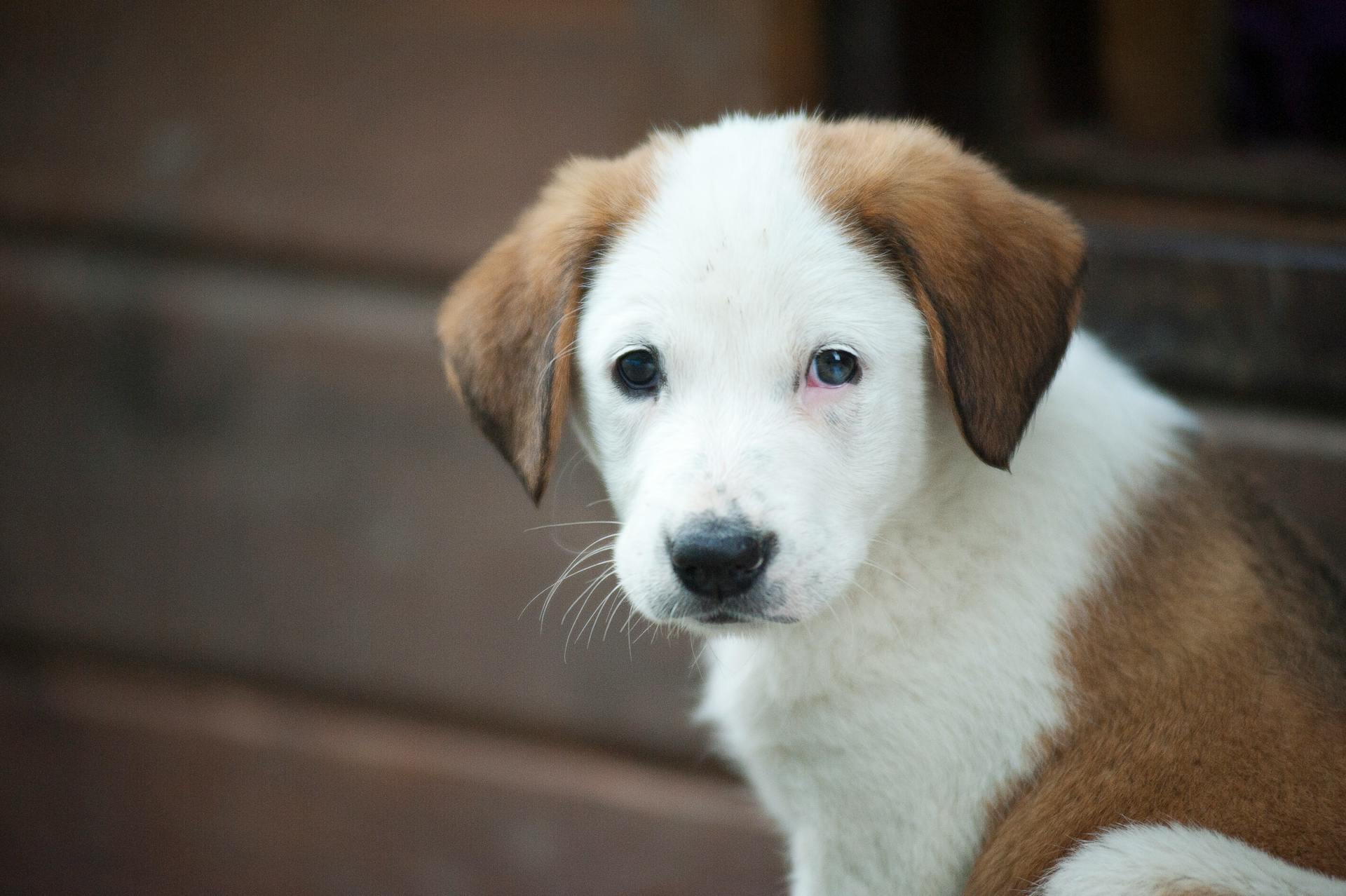
Dog onion toxicity is a serious concern for pet owners, and understanding the risks is crucial to keeping your furry friend safe. The toxic compounds in onions, such as N-propyl disulfide, can cause damage to a dog's red blood cells, leading to anemia.
Symptoms of onion toxicity in dogs may include vomiting, diarrhea, lethargy, and a lack of appetite. If left untreated, onion toxicity can progress to more severe symptoms like pale gums, rapid heartbeat, and even seizures.
The severity of onion toxicity depends on the amount and type of onion consumed. Even small amounts of onion can cause problems, and some breeds, such as Bulldogs and Pugs, are more susceptible to the effects of onion toxicity.
Readers also liked: Salt Water Toxicity in Dogs
What Happens If a Dog Eats?
Dogs don't have the right enzyme to digest onions and other plants in the allium family, leading to an auto-immune response towards their red blood cells.
This can cause hemolytic anemia, a serious condition that results in weakness, fatigue, and low blood pressure.
Symptoms of onion poisoning can start quickly, but most commonly appear a few days after ingestion.
As little as 0.5% of a dog's body weight in onions can be toxic, so a 40-pound dog could be at risk with just 0.2 pounds of onions.
For a small dog like a Yorkie, even a tiny amount of onion can be toxic.
If you have a larger breed and they sneak a small slice of onion, it probably won't cause too many issues, but it's still a good idea to monitor them closely and check in with your vet.
If your dog has eaten onions, the professionals will treat and monitor them, which may include intravenous fluids, oxygen support, or blood transfusions.
In severe cases, a pet poison control hotline may need to guide you through inducing vomiting in your dog at home using a substance like 3-percent hydrogen peroxide solution.
What to Do If Your Dog Eats
If your dog eats onion, it's crucial to act fast. Even a small onion can be toxic to a small or medium-sized dog. Contact your vet for advice immediately.
The type of information you'll need to provide includes the age, size, and breed of your pet, when they ate the onion, the specific type of food they ate, how much onion they ate, and any unusual symptoms or behavioral changes. Your vet will use this information to determine the best course of action.
If you can't reach your vet, consider visiting an animal hospital. The ASPCA Animal Poison Control Helpline is also available 24/7 to provide support and answer any questions.
The professionals will treat and monitor your dog, which may include intravenous fluids, oxygen support, or blood transfusions. If you can't reach a professional, call the pet poison control hotline for guidance.
In some cases, the hotline may advise you to induce vomiting in your dog at home using a 3-percent hydrogen peroxide solution.
Suggestion: Dog Ate Red Onion
Preventing Illness in Pets
Dogs will eat just about anything within reach, including onions, which can be toxic to them.
One way to keep your pet safe is to store onions and other allium vegetables out of reach, such as in a pantry or cupboard.
Avoid feeding your dog table scraps, even if they beg, as this can increase the risk of onion toxicity.
Reading food labels carefully and checking for onion powder and other unsafe seasonings is also crucial.
Educating family and houseguests about the risks of onion toxicity can help prevent accidents.
Here are some effective strategies to prevent onion toxicosis:
- Clean up promptly if these plants are dropped on the floor while cooking.
- Keep dogs out of the kitchen while preparing food.
- Fence any garden beds containing these plants.
- Ensure any indoor plants, garlic braids, or other means of growing or storing these plants are well out of reach of pets.
- Not sharing people food; storing leftover people food in sealed containers away from pets.
Toxicity and Treatment
If your dog ate onions, it's crucial to act quickly. Time is of the essence, so get your vet on the phone right away.
A typical treatment plan may involve inducing vomiting to remove the toxic onions from your dog's system. This is usually done if the onions were ingested recently.
Your vet may also administer activated charcoal to absorb the toxins in your dog's gut, and IV fluids to flush the bloodstream and maintain hydration. In severe cases, supplemental oxygen and blood transfusions may be necessary.
You might like: Vet Dogs Dog Treats
If your dog is suffering from onion toxicity, they will probably require veterinary attention. Your veterinarian may induce vomiting, depending on how recently your dog ate the onions, and will offer supportive care until your dog’s body can produce enough healthy red blood cells to replace the damaged ones.
In severe cases, your dog may require a blood transfusion. Onion toxicity can be fatal, so the faster you get your dog to the veterinarian, the better their chances.
A unique perspective: Onion Toxicity Dog
Diagnosis and Treatment
The diagnosis of onion toxicity in dogs typically involves a combination of history, clinical signs, and microscopic confirmation of a Heinz body-type hemolytic anemia. This is a crucial step in determining the severity of the condition and the best course of treatment.
Time is of the essence when it comes to treating onion toxicity, as the faster you get your dog to the veterinarian, the better their chances of recovery. Your veterinarian may induce vomiting in dogs, depending on how recently they ate the onions.
No specific antidote is available for onion toxicity, so treatment involves gastrointestinal decontamination, removing the onion source, treating the anemia, and providing general supportive care. Inducing emesis can be valuable in asymptomatic dogs and cats, but only if no complicating factors are present and ingestion was within the last one or two hours.
Activated charcoal may be administered after emesis to absorb toxins in the gut. In severe cases, a blood transfusion and supplemental oxygen therapy may be required to help your dog recover.
Carefully monitoring your dog's erythron for several days after ingestion is essential, as this is when the anemic nadir usually occurs.
Recommended read: Best Dog Food for Dogs with No Teeth
Clinical Signs and Lab Findings
Clinical signs of Allium species toxicosis in dogs and cats can appear within one day of consumption if large amounts of material have been ingested.
Clinical signs often include depression, hemoglobinuria, hemoglobin and possibly hemosiderin urinary casts, icterus, tachypnea, tachycardia, weakness, exercise intolerance, and cold sensitivity.
Inappetence, abdominal pain, and diarrhea may also be present.
The affected animal's breath may smell of onions or garlic if they've ingested the toxic material recently.
Clinical pathology findings are consistent with intravascular and extravascular hemolysis, Heinz body anemia, eccentrocytosis, hemoglobinemia, hemoglobinuria, hyperbilirubinemia, methemoglobinemia, and a regenerative response if the animal survives long enough.
Histopathologic findings may indicate hemolytic anemia, but are not specific for Allium species toxicosis.
Deposition of hemosiderin in the phagocytic cells of the liver, spleen, and renal tubular epithelium may also be seen.
Calculating and Managing Costs
Calculating the cost of a dog onion toxicity incident can be a significant expense, with veterinary treatment ranging from $500 to $5,000 or more.
It's essential to factor in the cost of treatment, including hospitalization, medication, and follow-up care.
A dog's age, size, and overall health can impact the cost of treatment, with larger dogs and older dogs often requiring more expensive care.
Toxicity Cost

Calculating the cost of a toxic encounter can be a daunting task. The equivalent of 0.5% of your dog's weight in onions can cause severe toxemia.
For a 10 kg dog, this amounts to 50 grams, or 1/3 of a medium onion. Consuming such an amount can lead to altered pet behavior and severe anemia.
It's worth noting that these effects can be life-threatening. If your dog ate onions, and you're unsure about the specific amount, don't hesitate to seek professional help.
Contacting your vet is the best course of action in this situation.
Additional reading: My Dog Ate a Slice of Onion
Calculating Dog Expenses
Calculating dog expenses can be a challenge, but it's essential to ensure your furry friend receives the best care. You'll want to consider the cost of regular check-ups and vaccinations.
The good news is, calculating some dog expenses can be as simple as a quick equation. For instance, if you need to calculate the cost of food for your dog, you can use the following equation: Total cost = Dog's weight (kg) × 2.5 (average daily food cost per kilogram).
Some dog expenses, like vet bills, can be unpredictable and vary depending on the situation. However, you can prepare by setting aside a monthly budget for unexpected expenses.
To give you a better idea of the costs involved, here's a rough breakdown of some common dog expenses:
Remember, these are just rough estimates, and the actual cost may vary depending on your dog's size, breed, and health.
Sources
- Pet Poison Helpline (petpoisonhelpline.com)
- ASPCA Animal Poison Control Helpline (aspca.org)
- Dog Onion Toxicity Calculator (omnicalculator.com)
- Onion Poisoning (Allium Toxicosis) in Dogs (vetster.com)
- Can Dogs Eat Onions? Everything You Need to Know (akc.org)
- Toxicology Brief: Allium species poisoning in dogs and cats (dvm360.com)
Featured Images: pexels.com


